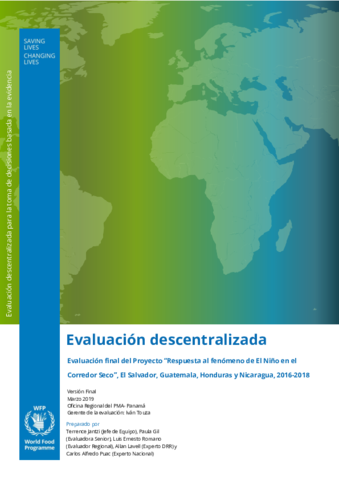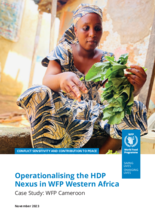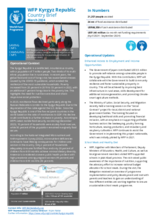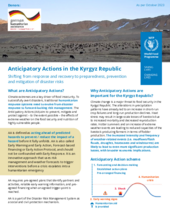
Managed by Panama Regional Bureau, this decentralized evaluation covers the regional project “Response to El Niño in the Dry Corridor” implemented by the WFP in El Salvador, Guatemala, Honduras, and Nicaragua from 2016 to 2018 and financed by the European Union. The area known as the Dry Corridor covers a large part of the central premontane region of these four countries. The phenomenon of El Niño has aggravated the climatic conditions limiting the capacity for livelihood recovery across the Dry Corridor, which has now accumulated impacts of prolonged periods of drought over a five-year period (2014-2018).
The primary objective of the project was to support the households most affected by El Niño in the four Dry Corridor countries, with a focus on building resilience. The report presents evidence-based findings for learning and accountability, with an emphasis on the former towards design of future WFP projects and programming in the Central American region.
Main conclusions:
- The Project was generally relevant to the context, WFP policies and norms, and to national programs and government priorities. It has produced tangible results at the community level in terms if resilience infrastructure, productive assets, and community and institutional capacities.
- Contributions to community life and territorial organizations were more rich and profound than what is captured by corporate indicators. Conceptualization and measurement of resilience do not capture the full potential using the project components.
- The greatest strength has been the fine-tuned application of 3PA to promote community- and municipality-level participation and commitment through multisectoral and multi-level strategies, generating a cascade of impacts both intended and unintended.
- WFP’s processes that limited some results were related to: a) purchases, administration, and internal structures; b) implicit design logic, such as assumption of access to land given its close association with vulnerability.
- Community planning (e.g. the chronological phases from CBT to maturation of short-term and long-term assets) needs more technical support to respond to potential gaps between the discontinuance of CBT and beginning asset production.
Main recommendations:
- To capitalize WFP’s experiences in the region with strategic orientation towards building resilience, with a cross-cutting theme of gender.
- For any resilience project in the Dry Corridor, to clearly define its focus related to the specific shock that the resilience-building work is designed to confront.
- Any future interventions related to resilience within the framework of the CSPs to be strategically oriented towards the most vulnerable, who depend on agricultural production but are not landowners.
- To integrate a chronogram of maturation of assets in processes of Community Based Participatory Planning.
- To build into future projects transition platforms and sustainability plans based on the experiences at the Municipal level, as well as incorporate a result focused on strengthening transnational networks and municipal platforms.
- To introduce small adjustments in internal corporate procurement processes to facilitate access to WFP markets for cooperatives or smallholder farmers in resilience projects.



